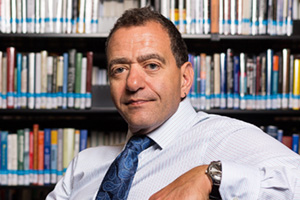UOIT faculty member assists in U.S. exoneration case
May 23, 2014

When presented with eyewitness testimony, a judge or jury may feel there is enough persuasive evidence to convict a person accused of a crime. But researchers like Dr. Brian Cutler, Professor and Associate Dean, Faculty of Social Science and Humanities at the University of Ontario Institute of Technology, will tell you that eyewitness identification of crime perpetrators is subject to error and in many cases has led to wrongful convictions.
Dr. Cutler has conducted research on eyewitness testimony for 30 years, and has testified or consulted in more than 150 cases in which eyewitness identification has been part of the primary evidence against a defendant. In the role of expert he has educated attorneys, judges, and juries about the psychology of eyewitness identification. “I’m part of a relatively small network of researchers who do this kind of work,” he explained. He also assists the Toronto, Ontario-based Association for the Wrongly Convicted (AIDWYC) with the exoneration cases they work on, and leads workshops for them on the topic.
Most recently, Dr. Cutler assisted Chicago, Illinois-based Northwestern University’s Center on Wrongful Convictions (CWC) in its efforts to exonerate Christopher Coleman, an innocent man who spent 19 years in prison for armed robbery, home invasion, residential burglary and aggravated criminal sexual assault, based on mistaken eyewitness testimony. Coleman was granted a new trial as a result of advocacy by the CWC. At the CWC’s request, Dr. Cutler reviewed the case file, submitted a report about the eyewitness identifications in the Coleman case, and was prepared to testify in the retrial on behalf of the center. In the end, the prosecutor dropped the charges against Coleman. A letter from Karen Daniel, Clinical Professor of Law, at CWC thanked Dr. Cutler for his assistance, adding that his expert report was “educational for the defense team.” He is also working with the Duke University School of Law’s Wrongful Conviction Clinic to exonerate Charles Ray Finch, who was convicted of murder based on questionable eyewitness identification and has been in prison in North Carolina since 1976.
According Dr. Cutler, between half and three-quarters of all known cases of wrongful conviction involved at least one, and sometimes multiple mistaken identifications of the perpetrators by eyewitnesses who were honest and confident but wrong. Part of his role is to review police reports, depositions and grand jury testimonies, and identify specific conditions in which the crime occurred that could have contributed to the risks of false identification. “Factors such as extreme stress or the presence of a weapon can make eyewitness testimonies less accurate,” he explained. Other factors that can lead to mistaken identity include identification of a person of another race and the manner in which a lineup is composed and conducted. “The confidence of the eyewitness is not a strong predictor of the accuracy of the eyewitness but confident witnesses are persuasive to judges and juries,” he explained.
Research on mistaken identification and wrongful conviction has prompted police services across Canada to improve their methods of collecting and presenting information to witnesses. For example, a witness used to be shown a lineup of six to eight photos simultaneously and asked to identify the person who committed the crime. These days, witnesses receive much better instruction; the photos are often shown one at a time so witnesses don’t get to compare them and just try to pick the one they think looks most like the perpetrator. If a police officer involved in the case shows the photo lineup, there is a risk that the officer will inadvertently convey his or her expectation of whom to pick, either verbally or non-verbally. Police services have since switched to blind administration, where another officer who doesn’t know the suspect’s identity conducts the photo array. These newer practices are based on research conducted by Dr. Cutler and researchers from other universities in Canada and the U.S.
“The number of documented cases of wrongful convictions continues to grow because of zealous advocacy efforts of AIDWYC in Canada and the Innocence Network in the U.S.; however, the eyewitness evidence is generally better than it used to be, because police are using techniques that have been developed through research,” he said. Nevertheless, even if best practices are used, eyewitnesses will still make mistakes, so more work is needed to ensure that mistaken identifications do not become wrongful convictions.”
Dr. Cutler says every time an innocent person is exonerated, it is both a tragedy and a victory. It is a tragedy because an innocent person was convicted in the first place and a victory because an egregious error was addressed. “An important lesson is that psychological science can be used to improve justice,” he said.